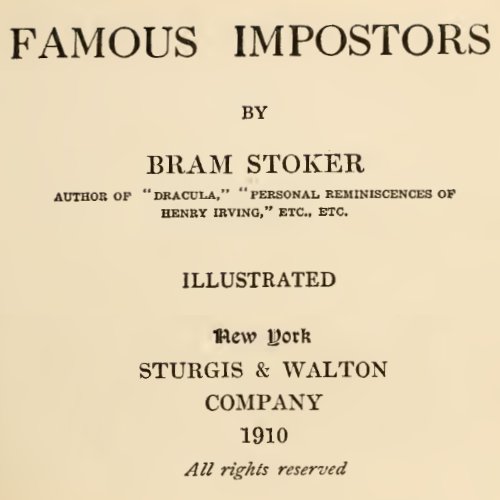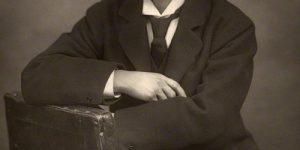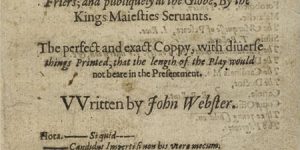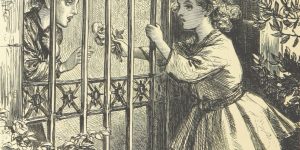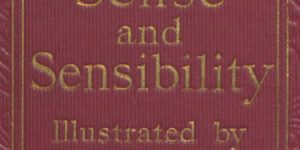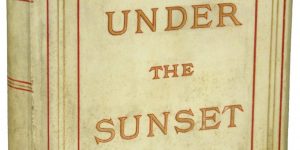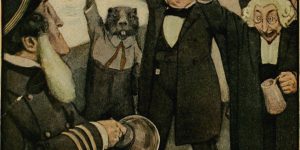Witches : Famous Impostors by Bram Stoker
Famous Impostors : Witchcraft and Clairvoyance Witches
by
Bram Stoker
Witches – The Period
For convenience, the masculine offender is in demonology classed under the female designation. According to Michelet and other authorities there were ten thousand alleged witches for each alleged wizard! and anyhow there is little etiquette as to the precedence of ladies in criminal matters.
The first English Statute dealing directly with witches appears to be the thirty-third of Henry VIII (1541) which brought into the list of felonies persons “devising or practising conjurations, witchcraftes, sorcerie or inchantments or the digging up of corpses,” and depriving such of the benefit of clergy. It was however repealed by I Edward VI Cap. 12, and again by I Mary (in its first section.). Queen Elizabeth, however, passed another Act (5 Elizabeth Cap. 16) practically repeating that of her father, which had been in abeyance for more than thirty years. The Statute of Elizabeth is exceedingly interesting in that it states the condition of the law at that time. The opening words leave no misunderstanding:
“Whereas at this day there is no ordinary nor condigne punishment provided against the wicked offences of conjurations or invocations of evil spirits, or of sorceries, inchantments, charmes or witchcraftes, which be practised to the obstruction of the persons and goods of the Queene’s subjects, or for other lewd purposes. Be it enacted that if any person or persons after the first day of June next coming, shall use practice, or exercise any invocations, or conjurations, of evill or wicked spirits, to or for any intent or purpose, or else if any person or persons after the said first day of June shall use, practice or exercise any witchcraft, enchantment, charme or sorcerie, whereby any person shall happen to be killed or destroied, that then as well every such offendour or offendours in invocations, or conjurations, as is aforesayde, their aydours and counsellors, as also everie such offendour or offendours in that Witchcrafte, enchantment, charme or sorcerie whereby the death of any person doth ensue, their ayders and counsellors, being of eyther of the sayde offences lawfully convicted and attainted, shall suffer paines of death, as a felon or felons, and shall lose the privilege and benefit of Clergy and sanctuary,” &c.
In this act lesser penalties are imposed for using any form of witchcraft or sorcery, for inducing to any persons harm, or to “provoke any person to unlawfull love or to hurt or destroy any person in his or her bodye, member or goods,” or for the discovery or recovery of treasure. From that time down to the first quarter of the eighteenth century, when the law practically died out, witchcraft had its place in the category of legal offences. The law was finally repealed by an Act in the tenth year of George II. The sixteenth and seventeenth centuries were the time of witch-fever, and in that period, especially in its earlier days when the belief had become epidemic, it was ruthless and destructive. It is said that in Genoa five hundred persons were burned within three months in the year 1515, and a thousand in the diocese of Como in a year. Round numbers in such matters are to be distrusted, as we find they seldom bear investigation; but there is little doubt that in France and Germany vast numbers suffered and perished. Even in more prosaic and less emotional England there were many thousands of judicial murders in this wise. It is asserted that within two centuries they totalled thirty thousand.
It is startling to find such a weird and impossible credulity actually rooted in the Statute book of one’s own country, and that there are records of judges charging juries to convict. Sir Matthew Hale, a great lawyer, a judge of the Common Pleas in 1654, and Lord Chief Justice in 1671, was a firm believer in witchcraft. He was a grave and pious man, and all his life was an ardent student of theology as well as of law. And yet in 1664 he sentenced women to be burned as witches. In 1716 a mother and daughter—the latter only nine years of age—were hanged in Huntingdon. In Scotland the last case of a woman being condemned as a witch occurred at Dornoch in 1722.
It is no easy task in these days, which are rationalistic, iconoclastic and enquiring, to understand how the commonalty not only believed in witchcraft but acted on that belief. Probably the most tolerant view we can take, is that both reason and enquiry are essential and rudimentary principles of human nature. Every person of normal faculties likes to know and understand the reasons of things; and inquisitiveness is not posterior to the period of maternal alimentation. If we seek for a cause we are bound to find one—even if it be wrong. Omne ignotum pro magnifico has a wide if not always a generous meaning; and when fear is founded on, if not inspired by ignorance, that unthinking ferocity which is one of our birthrights from Adam is apt to carry us further than we ever meant to go. In an age more clear-seeing than our own and less selfish we shall not think so poorly of primitive emotions as we are at present apt to. On the contrary we shall begin to understand that in times when primitivity holds sway, we are most in touch with the loftiest things we are capable of understanding, and our judgment, being complex, is most exact. Indeed in this branch of the subject persons used to call to aid a special exercise of our natural forces—the æsthetic. When witchcraft was a belief, the common idea was that that noxious power was almost entirely held by the old and ugly. The young, fresh, and beautiful, were seldom accepted as witches save by the novelty-loving few or those of sensual nature. This was perhaps fortunate—if the keeping down of the population in this wise was necessary; it is easier as well as safer to murder the uncomely than those of greater charm. In any case there was no compunction about obliterating the former class. The general feeling was much the same as that in our own time which in sporting circles calls for the destruction of vermin.
It will thus be seen that the profession of witchcraft, if occasionally lucrative, was nevertheless always accompanied with danger and execration. This was natural enough since the belief which made witchcraft dangerous was based on fear. It is not too much to say that in every case, professed witchcraft was an expression of fraudulent intent. Such pity, therefore, as the subject allows of must be confined to the guiltless victims who, despite blameless life, were tried by passion, judged by frenzy, and executed by remorseless desperation. There could be no such thing as quantitative analysis of guilt with regard to the practice of witchcraft: any kind of playing with the subject was a proof of some kind of wrongful intent, and was to be judged with Draconian severity. Doubtless it was a very simple way of dealing with evils, much resembling the medical philosophy of the Chinese. The whole logic of it can be reduced to a sorites. Any change from the normal is the work of the devil—or a devil as the case may be. Find out the normal residence of that especial devil—which is in some human being. Destroy the devil’s dwelling. You get rid of the devil. It is pure savagery of the most primitive kind. And it is capable of expansion, for logic is a fertile plant, and when its premises are wrong it has the fecundity of a weed. Before even a savage can have time to breathe, his logic is piling so fast on him that he is smothered. If a human being is a devil then the club which destroys him or her is an incarnation of good, and so a god to be worshipped in some form—or at any rate to be regarded with esteem, like a sword, or a legal wig, or a stethoscope, or a paint-brush, or a shovel, or a compass, or a drinking-vessel, or a pen. If all the necessary conditions of life and sanity and comfort were on so primitive a base, what an easy world it would be to live in!
One benefit there was in witchcraft, though it was not recognised officially as such at the time. It created a new industry—a whole crop of industries. It is of the nature of belief that it encourages belief—not always of exactly the same kind—but of some form which intelligence can turn into profit. We cannot find any good in the new industry—grapes do not grow on thorns nor figs on thistles. The sum of human happiness was in no sense augmented; but at least a good deal of money or money’s worth changed hands; which, after all, is as much as most of the great financiers can point to as the result of long and strenuous success. In the organisation of this form of crime there were many classes, of varying risks and of benefits in inverse ratio to them. For the ordinary rule of finance holds even here: large interest means bad security. First there were the adventurers themselves who took the great risks of life and its collaterals—esteem, happiness, &c. The money obtained by this class was usually secured by fraudulent sales of worthless goods or by the simple old financial device of blackmail. Then there were those who were in reality merely parasites on the pleasing calling—those timorous souls who let “‘I dare not’ wait upon ‘I would’ like the poor cat i’ the adage.” These were altogether in a poorer way of trade than their bolder brothers and sisters. They lacked courage, and sometimes even sufficient malice for the proper doing of their work; with the result that success seldom attended them at all, and never heartily. But at any rate they could not complain of inadequate punishment; whenever religious zeal flamed up they were generally prominent victims. They can in reality only be regarded as specimens of parasitic growth. Then there came the class known in French criminal circles as agents provocateurs, whose business was not only to further ostensible crime but to work up the opposition against it. Either branch of their art would probably be inadequate; but by linking their services they managed to eke out a livelihood. Lastly there was the lowest grade of all, the Witch-finder—a loathly calling, comparable only to the class or guild of “paraskistae” or “rippers” in the ritual of the Mummy industry of ancient Egypt.
Of these classes we may I think consider some choice specimens—so far as we may fittingly investigate the personnel of a by-gone industry. Of the main body, that of Wizards and Witches or those pretending to the cult, let us take Doctor Dee and Madame Voisin, and Sir Edward Kelley and Mother Damnable—thus representing the method of the procession of the unclean animals from the Ark. Of the class of Witchfinders one example will probably be as much as we can stand, and we will naturally take the one who obtained fame in his calling—namely Matthew Hopkins, who stands forth like Satan, “by merit raised to that bad eminence.”
Famous Impostors
Chapter I. Pretenders
A. Perkin Warbeck
B. The Hidden King
C. Stephan Mali
D. The False Dauphins
E. Princess Olive
Chapter II. Practitioners of Magic
A. Paracelsus
B. Cagliostro
C. Mesmer
Chapter III.
The Wandering Jew
Chapter IV.
John Law
Chapter V. Witchcraft and Clairvoyance
A. Witches
B. Doctor Dee
C. La Voisin
D. Sir Edward Kelley
E. Mother Damnable
F. Matthew Hopkins
Chapter VI.
Arthur Orton (Tichborne claimant)
Chapter VII. Women as Men
A. The Motive for Disguise
B. Hannah Snell
C. La Maupin
D. Mary East
Chapter VIII. Hoaxes, etc.
A. Two London Hoaxes
B. The Cat Hoax
C. The Military Review
D. The Toll-Gate
E. The Marriage Hoax
F. Buried Treasure
G. Dean Swift’s Hoax
H. Hoaxed Burglars
I. Bogus Sausages
J. The Moon Hoax
Chapter IX.
Chevalier d’Eon
Chapter X.
The Bisley Boy

